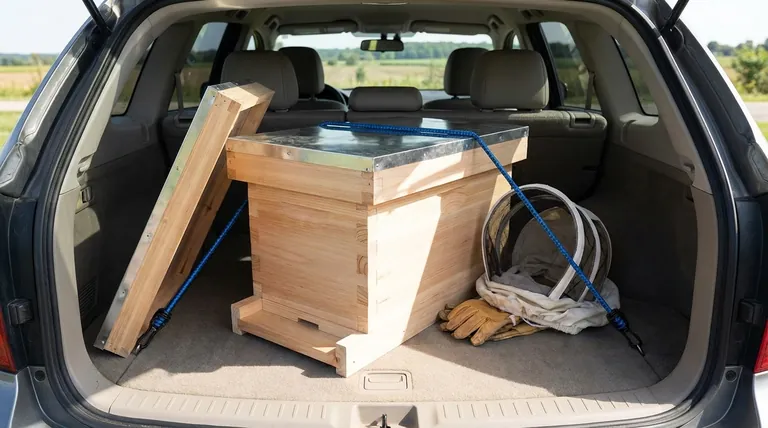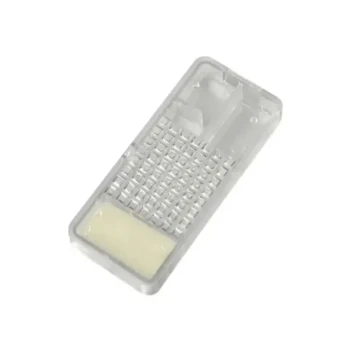To transport a nucleus colony (nuc), you must secure it in a well-ventilated space, out of direct sunlight and wind. The most critical step is to orient the frames so they are parallel to the direction of travel, which prevents the frames from swinging and crushing bees or damaging the delicate comb during stops and starts.
Transporting a new colony is a simple task, but it is not forgiving of error. The core principle is to protect the bees from the three primary dangers of transit: overheating, physical shock, and escape.

Preparing Your Vehicle and Gear
The journey begins before you pick up the bees. A few minutes of preparation will prevent the most common and stressful problems.
Create a Stable, Secure Location
Your goal is to prevent the nuc box from sliding, tipping, or vibrating excessively. The trunk of a car or the floor of a backseat are often the best locations. Ensure the surface is flat and clear of any objects that could puncture or block the nuc's ventilation screens.
Gather Essential Equipment
While the nuc should be sealed, it is wise to be prepared for the unexpected. At a minimum, have a bee veil handy. A tie-down strap or bungee cord can be invaluable for securing the box so it cannot shift. Placing an old sheet or towel underneath the nuc can also make cleanup easier.
The Critical Steps for Safe Transit
Once you have the nuc, your handling of it determines the health of the colony that arrives at your apiary.
Ensure Proper Ventilation
A nuc is a dense cluster of thousands of bees generating significant heat. Overheating is the single greatest risk during transport. Nuc boxes have built-in vents; confirm they are open and unobstructed. In your vehicle, provide gentle air circulation, but avoid blasting air conditioning directly onto the box.
Orient the Frames Correctly
The frames inside the nuc hang from a top ledge, much like a file in a filing cabinet. If they are perpendicular to the car's motion, they can swing violently during acceleration and braking. This "pendulum effect" can break comb, kill the queen, and crush countless bees. Always place the frames parallel to the direction of travel.
Secure the Nuc Box
Use your straps or wedge the box firmly in place. It must not be able to move. A secure box minimizes stress on the bees and prevents damage to the comb structure they have worked so hard to build.
Double-Check the Entrance
Before placing the nuc in your vehicle, ensure the entrance is securely sealed. Most commercially sold nucs have a built-in rotating door or other mechanism for this purpose. A few stray bees are common, but a steady stream indicates a problem that must be addressed before you start driving.
Common Pitfalls to Avoid
Mistakes during transport are easy to make but can have devastating consequences for a young colony.
The Danger of Overheating
Never leave a nuc in a parked car, even for a few minutes. On a warm day, the interior of a car can become an oven, and the heat generated by the bees themselves will quickly cook the colony. This is the most common and catastrophic mistake new beekeepers make.
Driving Too Aggressively
Your driving style matters. Avoid sudden stops, sharp turns, and bumpy roads whenever possible. Smooth, gentle driving reduces the physical shock and stress experienced by the bees.
Forgetting Your Protective Gear
Even a well-sealed nuc can have a few "hitchhiker" bees on the outside of the box, or a tiny gap you didn't see. Having a veil provides peace of mind and ensures that a single bee in the car doesn't turn into a dangerous distraction.
Arriving at Your Apiary: Next Steps
Getting your bees home safely is the primary goal. What you do upon arrival sets them up for a successful transition.
- If you plan to install the nuc immediately: Place the nuc directly beside or on top of its final hive location. Open the entrance and give the bees 15-30 minutes to calm down and orient themselves before you begin transferring frames.
- If you need to wait several hours or until the next day: Place the nuc in its final intended location within your apiary. Open the entrance so the bees can begin orientation flights and relieve themselves. This prevents them from becoming disoriented when you install them later.
- If you discover a few bees in your car: Do not panic. Simply park the car, open the doors or windows, and walk away. The bees will almost always find their way out on their own within a few minutes.
Successfully bringing your new colony home is the first rewarding step in your journey as a beekeeper.
Summary Table:
| Key Consideration | Action Required |
|---|---|
| Frame Orientation | Align frames parallel to the direction of travel. |
| Ventilation | Ensure nuc box vents are open and unobstructed. |
| Securing the Nuc | Use straps or bungee cords to prevent movement. |
| Temperature Control | Avoid direct sunlight and never leave in a parked car. |
| Driving Style | Drive smoothly to minimize stress and shock. |
Ensure your apiary's success with reliable equipment from HONESTBEE.
Transporting your nucleus colonies safely is just the first step. Equip your commercial operation or distribution business with the durable, well-designed supplies needed for every stage of beekeeping. From secure nuc boxes to essential hive tools, our wholesale-focused offerings are built to support the scale and demands of professional beekeepers.
Contact our team today to discuss your equipment needs and discover how HONESTBEE can contribute to the health of your bees and the productivity of your business.
Visual Guide

Related Products
- 5 Frame Wooden Nuc Box for Beekeeping
- Twin Queen Styrofoam Honey Bee Nucs Mating and Breeding Box
- Automatic Heat Preservation 6 Frame Pro Nuc Box for Honey Bee Queen Mating
- Plastic Transporting Bee Packages and Nuc Boxes for Beekeeping
- Styrofoam Mini Mating Nuc Box with Frames Feeder Styrofoam Bee Hives 3 Frame Nuc Box
People Also Ask
- How many frames does a typical wooden nuc box hold? A Guide to Choosing the Right Size
- What is a common feature of many 5-frame nuc boxes? The Integrated Feeder for Efficient Colony Growth
- What frames should be moved into the queenless hive when requeening with a nuc? Ensure a Successful Queen Introduction
- What is the purpose of having a nuc in beekeeping? Build a Resilient & Productive Apiary
- What are the benefits of starting a new bee colony in a nuc box? Boost Colony Success with Efficient Beekeeping



















